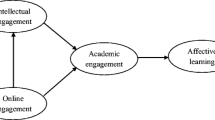Abstract
One of the problems in measuring affective outcomes from visits to science education centres like the CSIROSEC laboratories, is that different students have quite different experiences. They attend to different sets of activities or exhibits for different lengths of time, they have different amounts of previous knowledge and they may interact in different ways. Measurement of affective outcomes must take account of this diversity and, if it is to be useful for teachers, a measuring instrument must be brief, easy to understand and to score. This paper reports the results of a pilot study which devised a way of measuring affective outcomes from visits to a CSIROSEC. Specifically, students responded in terms of how easy they found various aspects of the activities, their enjoyment of what they did, and how helpful they found the visit in terms of their wider views and understanding about science and scientists.
Similar content being viewed by others
References
Bitgood, S. (1989). School field trips: An overview.Visitor Behaviour, 4(2), 3–6.
Blud, L. M. (1990). Social interaction and learning among family groups visiting a museum.International Journal of Museum Management and Curatorship, 9, 43–51.
Boyd, W. L. (1993). Museums as centres of learning.Teachers College Record, 94, 761–770.
Erätuuli, M. & Sneider, C. (1990). The experiences of visitors in a physics discovery room.Science Education, 14, 481–493.
Falk, J. H., & Dierking, L. D. (1992).The museum experience. Washington, DC: Whalesback Books.
Finson, K. D., & Enochs, L. (1987). Student attitudes toward science-technology-society resulting from a visit to a science-technology museum.Journal of Research in Science Teaching, 24, 593–609.
Flexer, B. K., & Borun, M. (1984). The impact of a class visit to a participatory science museum exhibit and a classroom science lesson.Journal of Research in Science Teaching, 21, 863–873.
Fortner, R. W., & Lahm, A. C. (1990). Research program outreach into the classroom: An estuarine research reserve initiative.Journal of Environmental Education, 21, 7–12.
Gottfried, J. L. (1980). Do children learn on school field trips?Curator, 23, 165–174.
Hidi, S., Soren, B., & Weiss, J. (1994, April).Interest in science and technology. Paper presented at the annual meeting of the American Education Research Association, New Orleans, MI.
Koran, J. J. Jr., & Ellis, J. (1991). Research in informal settings: Some reflections on designs and methodology.ILVS Review, 2, 67–86.
Koran, J. J. Jr., Koran, M. L. (1983). The roles of attention and curiosity in museum learning.Journal of Museum Education, 8(2), 14–17, 24.
Koran, J. J. Jr., Koran, M. L., & Ellis, J. (1989). Evaluating the effectiveness of field experiences: 1939–1989.Visitor Behaviour, 4(2), 7–10.
Lucas, A. M., McManus, P., & Thomas, G. (1986). Investigating learning from informal sources: Listening to conversations and observing play in science museums.European Journal of Science Education, 8, 341–352.
McManus, P. (1988). Good companions: More on the social determination of learning-related behaviour in a science museum.International Journal of Museum Management and Curatorship, 7, 37–44.
McManus, P. (1993). Thinking about the visitors thinking. In S. Bicknell & G. Farmelo (Eds.),Museum studies in the 90s (pp. 108–113). London: Science Museum.
Martin, M., Brown, S., & Russell, T. (1991). A study of child-adult interaction at a natural history centre.Studies in Educational Evaluation, 17, 355–369.
Rennie, L. J. (1986). The influence of the social context of the classroom on the relationship between subject-related affect and achievement.Education Research and Perspectives, 13(2), 75–97.
Rennie, L. J. (1993). Measuring cognitive outcomes from interactive science centres. In R. Schibeci (Ed.),Proceedings of the Eighteenth Annual Conference of the Science Education Association of Western Australia (pp. 117–125). Murdoch University, Perth.
Rennie, L. J., & Elliott, M. T. (1991). What students do at CSIROSEC. In M. W. Hackling (Ed.),Proceedings of the Sixteenth Annual Conference of the Science Education Association of Western Australia (pp. 117–125). Edith Cowan University, Perth: Edith Cowan University, Dept. of Science Education.
Rennie, L. J., McClafferty, T. P., & Johnston, D. (1993, November).Interactive science and technology centres: Helping teachers make the best use of them. Paper presented at the annual conference of the Australian Association for Research in Education, Fremantle, Western Australia.
Roberts, L. C. (1991). Affective learning, affective experience: What does it have to do with museum education? In A. Benefield, S. Bitgood & H. Shettel (Eds.),Proceedings of the 1991 Visitor Studies Conference (Vol. 4, pp. 162–113). Ottawa, Canada.
Roberts, L. C. (1993). Analysing (and intuiting) the affective domain. In S. Bicknell & G. Farmelo (Eds.),Museum studies in the 90s (pp. 97–101). London: Science Museum.
Stevenson, A., & Bryden, M. (1991). The National Museums of Scotland's 1990 Discovery Room: An evaluation.International Journal of Museum Management and Curatorship, 7, 24–36.
Stronck, D. R. (1983). The comparative effect of different museum tours on children's attitudes and learning.Journal of Research in Science Teaching, 20(4), 283–290.
Tuckey, C. J. (1992). Schoolchildren's reactions to an interactive science centre.Curator, 35, 28–38.
Wolins, I. S., Jensen, N., & Ulzheimer, R. (1992). Children's memories of museum field trips: A qualitative study.Journal of Museum Education, 17(2), 17–27.
Author information
Authors and Affiliations
Additional information
Specializations: gender issues and assessment in science and technology education.
Rights and permissions
About this article
Cite this article
Rennie, L.J. Measuring affective outcomes from a visit to a Science Education Centre. Research in Science Education 24, 261–269 (1994). https://doi.org/10.1007/BF02356352
Issue Date:
DOI: https://doi.org/10.1007/BF02356352




